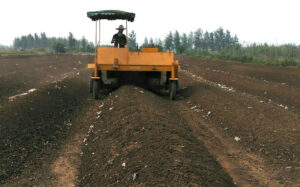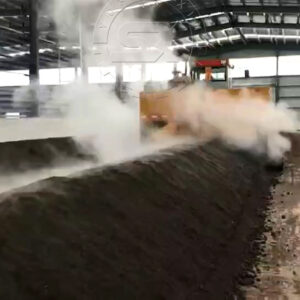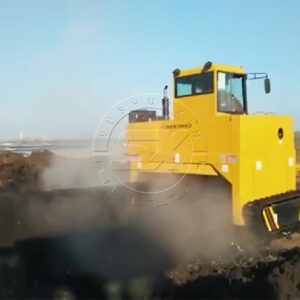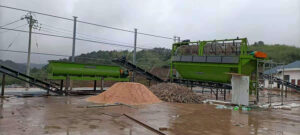Category: fertilizer coater
How to make cow manure compost
Composting is a great way to turn organic waste into nutrient-rich soil. One common material used for composting is cow manure. Cow manure is a rich source of nitrogen, phosphorus, and potassium, making it an ideal ingredient for compost. In this article, we’ll discuss the steps involved in making cow manure compost.

cow dung compost
Step 1: Collecting the cow manure The first step in making cow manure compost is to collect the cow manure. You can collect it from a local farm or buy it from a garden center. Make sure that the cow manure is well-aged and has been stored for at least six months. Fresh cow manure is too strong and can burn plants, so it’s important to let it age before using it in compost.
Step 2: Preparing the compost pile The next step is to prepare the compost pile. You can use a compost turner or create a compost pile on the ground. If you’re using a compost turner, make sure it’s at least 3 feet wide, 3 feet deep, and 3 feet tall. This will ensure that there’s enough space for the cow manure to decompose properly.

cow dung compost
Step 3: Adding the cow manure Once the compost pile is ready, it’s time to add the cow manure. Spread a layer of cow manure on the bottom of the compost pile, making sure it’s evenly distributed. Then add a layer of dry leaves or straw on top of the cow manure. This will help balance the nitrogen-rich cow manure with carbon-rich material.
Step 4: Turning the compost pile After adding the cow manure and dry leaves, it’s time to turn the compost pile. This is an important step as it helps to mix the ingredients and ensure that the compost decomposes evenly. Use a cow dung compost turner to turn the compost pile every few weeks. Make sure to mix the outer layer with the inner layer to speed up the composting process.

windrow compost turner for cow dung compost
Step 5: Watering the compost pile Cow manure compost needs to be kept moist, but not too wet. Water the compost pile regularly to keep it moist. If the compost pile is too wet, it can become anaerobic, which can slow down the decomposition process. Aim for a moisture content of around 50%.
Step 6: Checking the temperature of the compost pile As the cow manure compost decomposes, it will generate heat. Check the temperature of the compost pile regularly using a compost thermometer. The ideal temperature for composting cow manure is between 120 and 150 degrees Fahrenheit. If the temperature is too low, the compost pile may not decompose properly. If the temperature is too high, it can kill the beneficial microorganisms that break down the compost.
Step 7: Harvesting the compost After several weeks or months, the cow manure compost will be ready to use. The compost will be dark brown and crumbly, with a rich earthy smell. Use a garden fork to harvest the compost from the bottom of the pile. Spread the compost over your garden beds or mix it with potting soil to enrich it with nutrients.
In conclusion, making cow manure compost is a simple process that requires a little patience and effort. By following these steps, you can turn cow manure into a nutrient-rich soil amendment that will benefit your plants and the environment.
Of course, you can check this page for more details about how to make cow manure compost!
Good Reasons To Use a Coating Machine to produce Colorful Fertilizer Granules
The process of making fertilizer granules is actually a time-consuming and laborious one. The old-fashioned way involved hand mixing water, fertilizers, and other ingredients to make the paste that will then be formed into small balls by hand. This technique was not only very tedious but in addition created an inconsistent product and also many side effects for that workers.
Thankfully nowadays there are significantly better strategies to produce fertilizer granules which were made possible through advancements in technology for example coating machines from leading manufacturers.
Coating machines are used by fertilizer manufacturers to produce uniform balls of fertilizer that have ideal particle size distribution. These granules can then easily be applied into the soil at various depths based on the sort of plant being grown. Sizes of fertilizer pellets are accessible for several types of plants and their specific needs, therefore they must have the correct dimensions of granules for their root structure. The granules are able to simply be released to the soil since they are naturally biodegradable.

Fertilizer coating machine
These powerhouse machines can produce large volumes of pellets quickly, rendering it an excellent piece of machinery for manufacturers who want to increase production without adding more workers or spending more hours on the manufacturing process itself. This automation saves both money and labor costs as well as makes certain that there may be virtually no room for error when producing fertilizer pellets.
Coating machines also have various different strategies to coat pellets with some other materials, including colorants as well as other nutrients which can help plants grow faster and healthier. A piece of equipment can produce consistent results every time which ensures the quality of fertilizer being produced will never waver after a while. Using coating technology allows manufacturers to customize their products so customers are fully aware of just what they are getting with every purchase.

Fertilizer coating machine inner details
This advancement in technology is really a win-win for both customers and manufacturers because it allows the creation of better quality products which can be sold for less money point on account of increased efficiency throughout each and every aspect of manufacturing. It can also help to remove labor issues, that has been once the most significant problems from the fertilizers manufacturing industry.
Different styles of coating machines can be used based on the type and hue of fertilizer granules that need to be produced. By way of example, a two-roll mill is great for making black or white pigmented products like zinc oxide, titanium dioxide, etc., whereas an aura float machine having its horizontal design works for producing colored fertilizers including individuals with red or blue pigmentation.

Fertilizer granules coated by fertilizer coating machine
One of the best ways to actually are buying quality fertilizer coating machineshttps://www.fertilizerplantcost.com/fertilizer-coating-machine/ is to consider an established manufacturer who has established a great name in the market. Getting the right equipment ensures that you may be getting consistent, high-quality results each and every time. You ought to take into account that this bit of machinery might be one of the more important pieces in terms of producing fertilizer.
With advancements such as these, it is obvious why coating machines are quickly transforming into a must-have for fertilizer manufacturers and suppliers around the world!







How to generate your own organic fertiliser from poultry waste and farm waste
May 17, 2023
A Full Deck of Cards, Agriculture, Animal Farm, Animal manure management, BB fertilizer production, Bentonite Pellets Making Mahcine, bio fertilizer production line, bio fertilizer production project, Biotech, Bulk blending fertilizer making, Business Manufaturer, Business Supplier, Car Share, chemical fertilizer making, chicken compost, chicken manure composting, Community Design, Complex fertilizer manufacturing system, Compost Equipment, compost fertilizer production, Compost Technology, Composting, Compound fertilizer making equipment, Compound fertilizer making line, compound fertilizer manufacturing, Cow dung as fertilizer, Cow dung fertilizer making machine, Dispose of animal manure, Double Roller Granulator, Dry fertilizer pellet mking machine, Earthworms, Etc, Energy, Enterpreneurship, Fertilizer, fertilizer coater, fertilizer coating machine, Fertilizer Drying Machine, fertilizer equipment, Fertilizer Factory, Fertilizer Granulating Machine, fertilizer granulator, fertilizer making machine, Fertilizer Plant, fertilizer processing, fertillizer production line, Fiber, Financing, Food, Fuels, Fun, Growing, Health, Healthing & Health, Housing, How To....., Life Long Learning, machine for coating fertilizer pellets, making bio fertilizer, making organic fertilizer, manure recycling, Manure separator, NPK fertilizer pelletizer, NPK fertilizer plant, NPK fertilizer production line, NPK fertilizer production line manufacturer, Open Space, organic fertilizer granulator, Organic fertilizer making line, Organic fertilizer manufacturing, Organic Fertilizer Production Line, organic fertilizer production machine, Organic Fertilizer Wet Granulating, Organic Waste Compost, Pedestrain, Pelletizer Used For Bentonite, poultry manure pelletizer, powdery organic fertilizer making
Comments Off on How to generate your own organic fertiliser from poultry waste and farm waste
cs
Generating your own organic fertilizer from poultry waste and farm waste is not only an eco-friendly solution but also a cost-effective way to enrich your soil and enhance the overall health of your plants. By harnessing the nutrient-rich properties of these waste materials, you can create a sustainable and self-sufficient system that promotes a healthier environment. In this article, Shunxin will explore the steps involved in generating your own organic fertilizer from poultry waste and farm waste.
pan granulator for poultry manure fertilizer making
The first step in the process is to gather the necessary materials. You will need poultry waste, such as chicken manure, along with farm waste, such as crop residues, grass clippings, and leftover plant material. It is important to ensure that the poultry waste is collected from healthy birds and that no antibiotics or chemicals have been administered to them. Similarly, the farm waste should be free from pesticides and herbicides.
Once you have collected the waste materials, the next step is to compost them. Composting is a natural decomposition process that converts organic matter into nutrient-rich humus. Start by creating a compost pile in a suitable location. Make sure the area receives adequate sunlight and is well-drained. Layer the poultry waste and farm waste, alternating between dry and wet materials. Dry materials can include straw, sawdust, or dried leaves, while wet materials encompass green plant trimmings and poultry manure.
Small scale compound fertilizer mkaing line
To accelerate the decomposition process, it is advisable to turn the compost pile regularly. This helps to introduce oxygen, which is essential for the growth of beneficial bacteria and other microorganisms that break down the organic matter. Additionally, ensure that the compost pile remains moist but not overly wet. If the compost becomes too dry, sprinkle water to maintain the proper moisture level.
Over time, the compost pile will heat up as a result of microbial activity. This is an indication that the decomposition process is underway. Regularly check the temperature of the compost pile with a thermometer, aiming for a range between 130°F and 150°F (54°C and 65°C). If the temperature exceeds this range, turn the pile more frequently to cool it down. On the other hand, if the temperature remains too low, consider adding nitrogen-rich materials, such as grass clippings or poultry manure, to boost the decomposition process.
The composting process typically takes several weeks to several months, depending on various factors such as temperature, moisture, and the size of the compost pile. During this time, monitor the compost for any foul odors. A well-maintained compost pile should have an earthy smell, while unpleasant odors may indicate an imbalance in the composting process. Adjust the carbon-to-nitrogen ratio by adding more dry or wet materials accordingly.
Organic fertilizer granulating machine for sale
Once the compost has fully decomposed, it will resemble dark, crumbly soil and emit a pleasant earthy aroma. At this stage, it is ready to be used as organic fertilizer. Spread the compost over your garden beds or mix it with potting soil for potted plants. The nutrient-rich organic matter will improve soil structure, retain moisture, and provide essential nutrients to your plants, promoting their growth and productivity.
By generating your own organic fertilizer from poultry waste and farm waste, you not only reduce the amount of waste that goes to landfills but also create a sustainable source of nutrients for your plants. This practice promotes a circular economy where waste is transformed into valuable resources. Start composting today and reap the benefits of healthier plants, reduced environmental impact, and increased self-sufficiency in your gardening endeavors.
Now, check our website for more about organic fertilizer production and get an affordable fertilizer production line!
animal manure as fertilizeranimal manure fertilizer productionautomatic cow dung fertilizer making machinebest compound fertilizer making equipmentchicken manure fertilizer